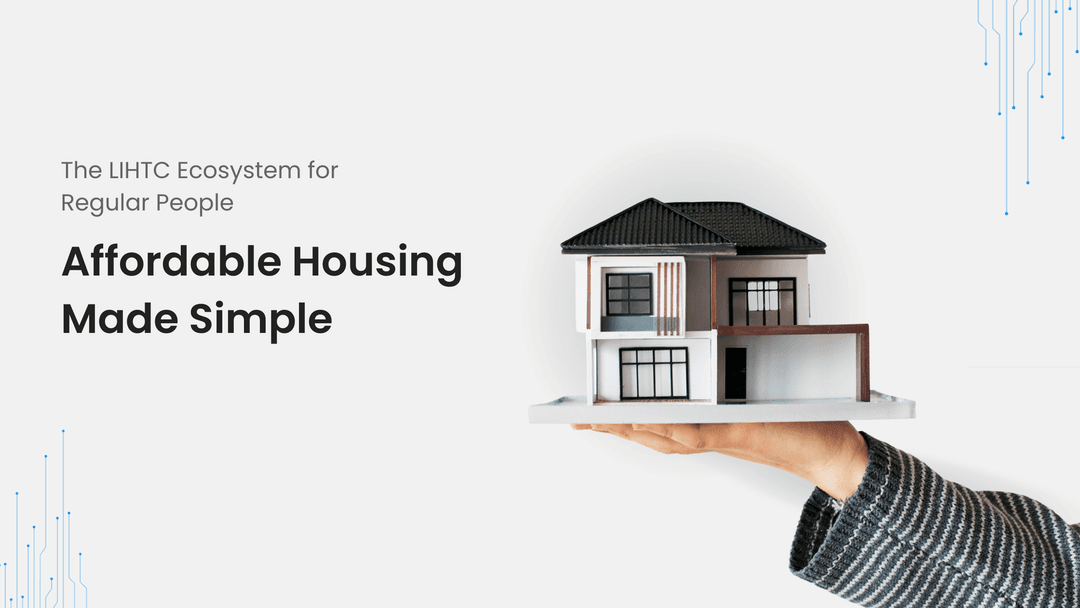Blogs| The LIHTC Ecosystem for Regular People – Affordable Housing Made Simple
Written by

Anuj Pratap
Published
Aug 29, 2024
Topics
LIHTC

With the fast-moving world and never-ending housing needs, having a safe place to call home has always been a priority for humans. But finding the perfect place to live that falls within your budget is easier said than done.
Affordable housing is one of the vital needs for many Americans. LIHTC is one way to support the availability of budgeted houses for low- or moderate-income tenants.
Despite the rising need for budget housing and the broad impact of the LIHTC programs, it’s hard to ignore the complexity of understanding the workings of LIHTC for regular people.
In this article, we will try to unveil the workings of the LIHTC program, breaking down its functionality and process, who benefits, and how LIHTC initiatives can help shape communities.
Whether you are looking for affordable housing options or just a curious reader willing to brush up your knowledge about LIHTC, this guide will come in handy.
The Low-Income Housing Tax Credit program was enacted as a part of the 1986 Tax Reform Act. It has been modified and reformed several times, considering the changes in the government policies. The federal government introduced this policy tool to use tax credits for construction and renovation and keep them affordable for people with low incomes.
LIHTC programs are pivotal to creating and maintaining affordable housing for low- or moderate-income tenants across the US. Its purpose is to encourage private companies to build affordable housing. Until now, the LIHTC initiative has helped build 3.5 million affordable homes for families needing a decent place to call home.
LIHTC, along with rent vouchers, helps the government deal with the lack of affordable housing for people with low to medium incomes.
The LIHTC program does not directly offer substantial incentives for developers and investors, making it an attractive route for affordable housing development. The LIHTC program is appealing for affordable housing development because it provides tax credits instead of direct incentives. Developers sell these credits for immediate capital, cutting costs and debt. This simple setup boosts financial viability and stability for affordable housing projects.
LIHTC provides developers with a valuable opportunity to secure tax credits, which can be sold to investors for immediate capital. This reduces debt and covers significant construction costs, making affordable housing projects financially viable.
Investors, typically large financial institutions, benefit from LIHTC by receiving a dollar-for-dollar reduction in federal income tax liabilities over a ten-year period. This investment supports community development efforts and complies with regulations such as the Community Reinvestment Act.
Participating in LIHTC projects also brings social impact benefits, enhancing the reputation of developers and investors as contributors to societal well-being. Additionally, developers may benefit from steady rental income once projects are completed and occupied, providing long-term stability in the real estate market.
Overall, LIHTC offers a win-win scenario for developers and investors, lowering financial risk, providing substantial tax benefits, and fostering community development.
The Low-Income Housing Tax Credit (LIHTC) program offers two types of tax credits, each serving different purposes and project types:
Ownership structures vary for LIHTC-funded properties. Private developers are often the primary owners, securing tax credits to finance construction or renovation. Investors like banks provide equity funding in exchange for tax credits. Nonprofits or housing authorities may also play a role when serving specific community needs.
The ownership structure influences management priorities. Private developers and investors typically focus on financial returns, which can impact decisions regarding rent levels and property maintenance. Nonprofits or housing authorities may prioritize community impact and tenant well-being over profits.
Regardless of ownership, all LIHTC properties must adhere to strict regulations, ensuring they remain affordable for low- and moderate-income households. Property owners must comply with income and rent restrictions, maintain quality standards, and undergo regular monitoring to verify tenant eligibility.
Navigating the complexities of LIHTC projects demands streamlined operations and heightened efficiency, which is where advanced technology plays a pivotal role.
A LIHTC software solution, referred to as Fusion, exists that is adept at handling every facet of the LIHTC process. Its capabilities span from initial project planning to meticulous compliance monitoring, offering various user-friendly features.
Fusion empowers stakeholders—developers, investors, or housing agencies—to manage their LIHTC initiatives skillfully, ensuring seamless project tracking, financial oversight, and regulatory compliance.
By harnessing Fusion’s capabilities thoughtfully embedded within its interface, stakeholders can optimize their LIHTC projects, silently contributing to the noble cause of creating and sustaining affordable housing for those in need.